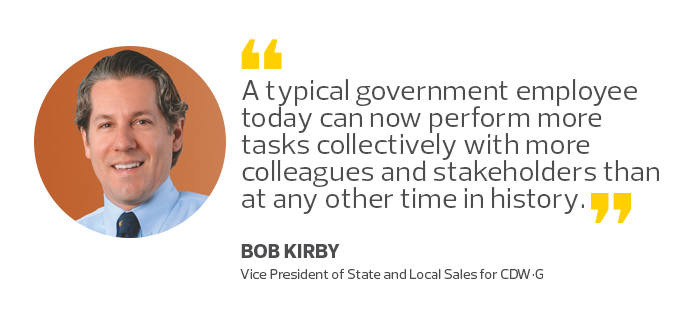Collaboration Tool Analytics Transform State and Local Agencies
Americans spend about two or three years of their lives waiting in line, says Richard Larson, a professor specializing in service industries at the Massachusetts Institute of Technology.
Clearly, that isn’t the most productive use of anyone’s time. And if you work in a state or local government agency, you want to deliver service as quickly and seamlessly as possible.
Thanks to the power of collaboration tools, state and local IT leaders are in a unique position to help government offices work more efficiently and expedite the delivery of citizen services. By analyzing patterns of collaboration that affect productivity and employee engagement, managers can evaluate how to empower productivity within their agencies, and take full advantage of technology that boosts productivity with insights from data analytics.
SIGN UP: Get more news from the StateTech newsletter in your inbox every two weeks!
Collaborate Fearlessly to Make the Most of Data
Today, we’re very much aware that wasting time is not good for productivity. Being productive means we have more money and more time for leisure pursuits, and constituents know that waiting in line or on hold is not good for either. Government workers also want to find ways to be as productive as possible.
Innovations in mobile devices and cloud-based management boost mobility and collaboration among government workers, improving productivity. Workers in remote government offices can bridge the distance with tools that empower them to collaborate in real time. For example, government agencies can effortlessly produce documents with solutions in the cloud. A typical government employee today can now perform more tasks collectively with more colleagues and stakeholders than at any other time in history.

Simple applications that we don’t often think of as having advanced collaborative capabilities, such as calendars, may enhance productivity tremendously. For instance, calendars impart a clear view of our schedules, let us see direct project ownership, and allow us to share information quickly. Government workers can synchronize their schedules and tasks with their colleagues, ensuring their availability to provide service when required.
“Further productivity benefits from enterprise technology require deeper levels of organizational commitment,” says Craig Roth, a research vice president at Gartner, in a recent blog. Surveys or focus groups may uncover obstacles to collaboration, he says. In government, leaders may then implement changes in their agencies to overcome these obstacles.
Data Insights Abound for Local Governments
With growth in collaboration tools comes a commensurate growth in data analytics tools, which can provide powerful insights into an agency’s productivity and engagement. Such solutions pool data from collaborative applications, including email, calendars, word processors and more, to produce metrics on office behavior. Equipped with those behavioral metrics, state and local IT leaders may detect patterns that contribute to success and foster greater collaborative efforts.
Office solutions that empower collaboration can also track behaviors of those using the products. These production suites provide data to managers who can aggregate it and share insights to help people become more effective in their jobs by pinpointing opportunities to collaborate.
It’s incumbent on IT leaders to take these steps within state and local government. Analytics tools collect data over the course of everyday work; individual employees are not required to do anything differently. But by using data analytics, managers can measure employees’ collective behaviors — no individual worker is singled out — to visualize how best to encourage engagement. Workplace analytics help leaders to understand trends and act on them.
In that way, we can truly change how we operate.
Analytics Support Future Public Sector Intelligence
State and local IT leaders will see even more opportunities for collaboration in the next five years as artificial intelligence and machine learning continue to enter government operations. As Chalmers Brown, co-founder and CTO of Due, advised on behalf of the Forbes Technology Council: “Find the tools that automate everything, from scheduling and bill pay to email responses and contact update lists. Also, add as many apps as possible that provide a way to digitize any manual processes such as list making or gift giving.”
We’ve already seen many agencies deploy AI through chatbots to help citizens with simple tasks. The automation of repetitive tasks will become more pervasive in the near future, opening the door for smart leaders to provide even more efficient service. The result will be a higher quality of life for everyone.









